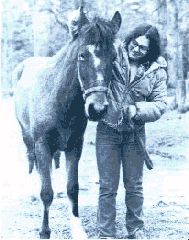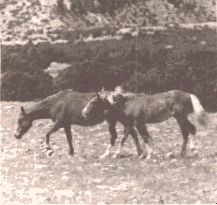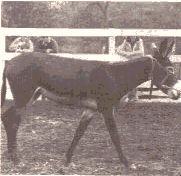| SO YOU'D LIKE TO ADOPT A WILD HORSE OR BURRO |

| Providing a home for a wild horse or burro is a rewarding and challenging responsibility. The BLM's unique "Adopt-A-Horse" and "Adopt-a-Burro" programs offer qualified individuals the chance to care for and own a living legend - a living symbol of American history - a wild horse or burro. This section is based on the BLM's information pamphlet of the same title and answers the most frequently asked questions about the programs. If you are interested in more information or have additional questions, please call the Bureau of Land Management (BLM) office serving your area. A complete listing of offices can be found on this website. |
|
1. Why does the Federal Government offer horses and burros for adoption?
The soil, water, and vegetation on the public rangelands in the West are managed for many uses. The vegetation on these arid lands is important to a wide variety of wild and domestic animals and prevents soil erosion. The number of animals on the public lands must be controlled to protect these resources and to maintain healthy animal herds, Livestock are managed through permits, which limit their numbers and seasons of use. Wildlife are managed by State game and fish departments. The health and welfare of wild horses and burros are maintained by limiting the number of animals to the capacity of the land they roam to provide food and water. To protect wild horse and burro herds, the law directs that excess numbers of these animals be removed from the range to "maintain a thriving natural ecological balance." Since 1973, the BLM has used the Adopt-A-Horse Program to place about 100,000 wild horses and burros in private care. Adopters acquire a living symbol of the "historic and pioneer spirit of the West," as Congress designated these animals. In addition, the adoption program helps the Government fulfill the mission of maintaining healthy herds of wild free-roaming horses and burros on public lands. 2. What is a wild horse or burro?A wild horse or burro is an unbranded and unclaimed free-roaming horse or burro found on public lands in the Western United States or one that has been removed from the public lands and has not lost this status by passage of title to an adaptor. These animals are protected by a law passed in 1971. Wild horses and burros are descendants of animals turned loose or escaped from ranchers, prospectors, Indian tribes. and the U.S. Cavalry from the late 1800s through the Great Depression of the 1930s, and in some areas even more recently. 3. How "wild" is a wild horse or burro?Until shortly before they are made available for adoption, wild horses and burros roam public rangeland in the West and are not accustomed to people. With kindness, patience, and gentleness, they can be trained for a wide variety of uses, as any domestic horse or burro can. Generally the younger animals, 1-4 years old, are more easily trained. However, many of the animals over 4 years of age will have received some training prior to adoption through a cooperative program between BLM and several State prison systems. 4. What kinds of horses and burros are available for adoption?
Burros average between 42 and 48 inches in height and weigh about 500 pounds. They are usually dun in color, although some are black or brown. Jacks and jennies of all ages are made available for adoption. As with horses, jennies and their unweaned foals can be adopted together for just one fee. 5. Where can I adopt a wild horse or burro?Adoptions are held at locations across the United States. Animals are available at BLM and contract facilities on a year-round basis. They can also be adopted at temporary centers in various locations. Some animals are adopted at the prison training centers. To find out where and when an adoption is scheduled near you, call the BLM office for your area. The offices are listed at this link. 6. Are there many wild horses and burros available for adoption?
Because a smaller number of burros are gathered each year, fewer are available for adoption. Adoption demand for burros is high, so if you want to adopt a burro, we ask for your patience. 7. Have the animals received any medical care?Every wild horse and burro offered for adoption has been examined by a veterinarian. Each animal has received necessary medical treatment, including tests for diseases, immunizations, and worming. A record of the animal's medical history is provided to the new adopter to assist in establishing a good health care program with a veterinarian. To keep your animal in good health, it is important to consult with a veterinarian, who will be able to advise you on the vaccinations your animal needs, parasite control, and a schedule for treatment. Because of the differences in diet and terrain between the open range and your pasture, the animal's teeth and hooves may need special care. Check teeth for uneven wear and sharp points. Your veterinarian can file dawn uneven spots. It will probably be necessary to trim your animal's hooves periodically. The frequency of hoof trimming and shoeing will vary with hoof wear and corral conditions. Consult a farrier to establish a regular program of hoof care and maintenance. 8. How can I qualify to adopt a wild horse or burro?You must be at least 18 years old, a resident of the United States, and have no convictions for inhumane treatment of animals. You must also have adequate facilities and financial means to provide humane care for the number of animals adopted. In addition, BLM will not adopt to an individual who has expressed an intent to use an adopted wild horse or burro for commercial purposes after receiving title. Although adopters must be at least 18 years old, a parent or legal guardian may adopt an animal and allow younger family members to assist in its care. Many young people train wild horses or burros for projects in youth organizations, such as 4-H, Future Farmers of America, scouts, and others. 9. How can I adopt?Just complete the application form included with this brochure and return it to the BLM office serving your area. You will be contacted as part of BLM's application review process. if your application is approved. you will be able to choose the animal you want at the adoption site. When adopting, you will sign a maintenance and care agreement to provide humane care for each animal. 10. How many wild horses and burros can l adopt?You can adopt four wild horses or burros in a 12-month period. The BLM may approve adoption of more animals if the adopter is capable of caring for them humanely. Under no circumstances, however, can an individual receive title to more than four adopted animals per year. (For more information on titling, see question 19.) 11. What does it cost to adopt a wild horse or burro?Effective March 7, 1997, adoption fees are $125 per horse or burro and $250 for a mare (or jenny) and foal together. Some sales may be undertaken on using a competitive bid process. The fee covers a small portion of the costs of the program from roundup to adoption, including veterinary care prior to adoption and shipping costs to a temporary adoption site or contract adoption center. Adopters are responsible for the cost of transporting the animal from the adoption site to its new home and, of course, future upkeep, including veterinary care. Caring for an animal is an ongoing expense. Adopters must be financially able to provide care for a wild horse or burro. 12. Does the adopted animal belong to me or to the Government?For the first year. the U.S. Government still owns the adopted wild horse or burro. When you sign your adoption agreement, you also apply for title to the animal. One year later BLM will send you an eligibility letter. Return the letter to BLM with a statement from a qualified person certifying that the animal has received proper care and is in good condition. When BLM approves the certification of proper care, title will be issued and the animal will be legally yours. There is no additional cost for titling the animal. During the waiting period before the adopter receives title. BLM or its agent may inspect the animal to make sure that it is being well cared for and that the adopter is living up to the conditions of the adoption agreement. A foal born to an adopted mare or jenny is not a wild horse or burro and belongs to the adopter. No waiting period is necessary and no title is issued. 
13. What should I bring to the adoption site?
14 . What kind of trailer is required for transporting the animals?Adopters must provide their own vehicles or make arrangements for transporting the animal from the adoption site to their home. Stock trailers are preferred, but other horse trailers can be used. All hauling equipment must meet the following standards:
For safety in loading an adopted animal unaccustomed to trailers, drop-ramp tailgates on horse trailers are discouraged and may be unacceptable. All trucks and trailers will be inspected by the authorized officer before loading. If you have any questions on the suitability of your truck or trailer, call the BLM office serving your area before the adoption. Continue to Part 2
Go to KBR Training SectionReturn to KBR World of Wild Horses & BurrosGo to other Wild Horse LinksGo To
| |
 The Departments of the Interior and Agriculture are
responsible for the protection and management of wild horses and
burros on public lands. Prior to 1971, wild horses and burros
were often killed or captured by mustangers and sold for
slaughter. Under Federal protection, the wild herds are thriving
and steadily increasing each year.
The Departments of the Interior and Agriculture are
responsible for the protection and management of wild horses and
burros on public lands. Prior to 1971, wild horses and burros
were often killed or captured by mustangers and sold for
slaughter. Under Federal protection, the wild herds are thriving
and steadily increasing each year. Wild horses are of no particular breed, although some exhibit
characteristics generally associated with specific breeds. While
there is some variation in size between herds, a typical wild
horse stands about 14 hands (56 inches at the shoulder) and
weighs about 900 pounds. The horses are usually solid colors,
such as sorrels, bays, and browns. The ages of most horses
offered for adoption range from a few months to 9 years.
Stallions, mares, and geldings are available, and some pairs of
mares with unweaned foals.
Wild horses are of no particular breed, although some exhibit
characteristics generally associated with specific breeds. While
there is some variation in size between herds, a typical wild
horse stands about 14 hands (56 inches at the shoulder) and
weighs about 900 pounds. The horses are usually solid colors,
such as sorrels, bays, and browns. The ages of most horses
offered for adoption range from a few months to 9 years.
Stallions, mares, and geldings are available, and some pairs of
mares with unweaned foals.